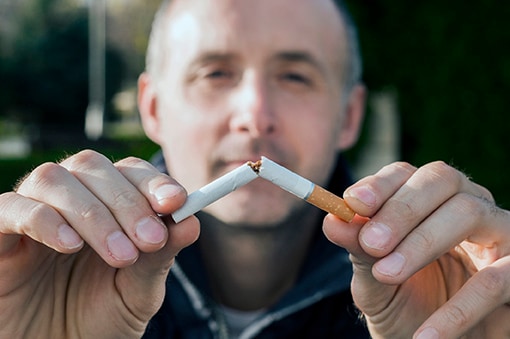
Everyone knows cigarette smoking is bad for you, but did you know it can lead to type 2 diabetes? And if you have diabetes, smoking can make it much worse. Learn how they’re connected and why quitting is one of the best things you can do for your health.
How Smoking Can Lead to Type 2 Diabetes
- Insulin helps blood sugar enter cells, but nicotine changes cells so they don’t respond to insulin, which increases blood sugar levels.
- Chemicals in cigarettes harm cells in your body and cause inflammation. This also makes cells stop responding to insulin.
- People who smoke have a higher risk of belly fat, which increases the risk for type 2 diabetes even if they aren’t overweight.
All in all, if you smoke, you’re 30% to 40% more likely to get type 2 diabetes than people who don’t smoke. The more you smoke, the higher your risk.
If You Have Diabetes

Breaking the habit is one of the best things you can do for your health.
Managing diabetes is challenging, and smoking can make it even more so. Nicotine increases your blood sugar levels and makes them harder to handle. People with diabetes who smoke often need larger doses of insulin to keep their blood sugar close to their target levels.
Diabetes causes serious health complications such as heart disease, kidney failure, blindness, and nerve damage that can lead to amputation (removal by surgery) of a toe, foot, or leg. If you have diabetes and smoke, you’re more likely to have complications—and worse complications—than people who have diabetes and don’t smoke.
Heart disease deserves special attention. It’s the leading cause of death in the United States, and both smoking and diabetes increase your risk. Over time, high blood sugar from diabetes can damage blood vessels as well as nerves in and around your heart. Cigarette smoking can damage blood vessels too by increasing plaque (a fatty, waxy substance that builds up on your artery walls).
Tips From Former Smokers
Ready for inspiration? Check out these compelling stories, part of CDC’s Tips From Former Smokers® campaign.
Quit for Good
No matter how long you’ve smoked—or how much—quitting will help you get healthier. As soon as you stop smoking, your body starts healing itself:
- In 20 minutes, your heart rate and blood pressure drop.
- In 12 hours, carbon monoxide (a toxic gas from cigarette smoke) in your blood drops to normal.
- In 2 weeks to 3 months, your circulation and lung function improve.
- In a year, your risk for heart disease is half that of someone who still smokes.
Quitting smoking also helps your body use insulin better, which can make your blood sugar levels easier to manage.
Blood Sugar Changes
If you have diabetes, you may need to check your blood sugar more often after you quit because your levels may go down. You won’t need to check as often after your body adjusts to being smoke-free.
Nicotine replacement products such as gum, patches, and lozenges are some of the best tools to help you stop smoking—they can double your chances of quitting for good. Products with nicotine raise your blood sugar, so be sure to talk to your doctor about using them if you have diabetes.
Help for Quitting
Don’t give up if you’re not able to quit on your first try. And don’t be too hard on yourself if you slip up. It can take several attempts until you’re smoke-free for good (though some people quit their first time). And you don’t have to do it alone: ask friends and family for support, try the free quitSTART app, and get free coaching to help you quit by calling 1-800-QUIT-NOW (1-800-784-8669; also available in Spanish and several Asian languages). And visit I’m Ready to Quit! for a wealth of online resources you can access right away.






















.png)











No hay comentarios:
Publicar un comentario